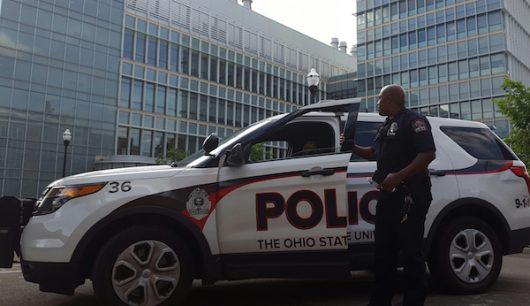
An Ohio State University police officer blocks off the road during an incident at the Chemical and Biomolecular Engineering and Chemistry building. Credit: Michael Huson | Managing Editor for Content
The Ohio State University Police Division is in the process of adopting state standards on law enforcement which include standards for “use of force,” “use of deadly force” and hiring practices that emphasize diversity.
OSUPD received provisional certification on July 11, and a state assessor will conduct an on-site review on Aug. 2, said Police Chief Craig Stone in an email.
“The Ohio State University Police Division is pleased to be a part of this statewide effort to improve the relationship between police and the community,” Stone said.
The standards, created by the Ohio Collaborative Community-Police Advisory Board, require an application and review process for full certification. In its effort to meet the standards, OSUPD had to revise existing regulations, conduct training and testing regarding use-of-force policies for officers, and conduct training and testing on recruiting and hiring policies of human resources personnel, Stone said.
“These standards were established to create accountability and instill confidence in the community,” said Kristen Castle, assistant communications director for the Ohio Department of Public Safety, which oversees the Ohio Collaborative. “It’s another step in our work to heal the relationship between the community and law enforcement.”
The process to create those standards was started by an executive order from Gov. John Kasich in December 2014 “after a series of incidents in Ohio and around the nation highlighted the challenging situations that exist in too many places between some communities and police,” according to the Ohio Collaborative website.
2014 saw the high-profile deaths of 12-year-old Tamir Rice in Cleveland; Michael Brown in Ferguson, Missouri; and Eric Garner in New York. All three were unarmed, black and died at the hands of the police, sparking protests across the country. The deaths also drew more attention to the Black Lives Matter movement, which started after the death of Trayvon Martin in 2013, who was also unarmed.
The executive order created a task force to examine police-community relations, and the Ohio Collaborative was created to oversee the implementation of the task force’s recommendations.
The standards were established in August 2015, and in January, the state announced the steps that agencies needed to take to establish compliance, including OSU, Stone said.
Standards will continue to be created and updated by the Ohio Collaborative, Castle said.
While Stone has previously called relations between OSU students and the police “great,” the nation has seen events this summer outside of OSU echoing the reasons for the standards’ creation in the high-profile deaths Philandro Castille and Alton Sterling.
Though the standards apply to all police agencies in Ohio, Stone said OSUPD has a slightly different mission than other departments.
“As a university agency, servicing a college campus which is home to nearly 100,000 students, faculty, staff and visitors, we have a uniquely tailored approach focusing on both safety and education,” Stone said. “This approach focuses on creating an environment of trust and support within the university community.”
There were 26 uses of force by OSUPD in 2015, though none of them deadly, Stone said. Stone also highlighted that the agency received 78 compliments from the community in that same time period.
There are no national mandatory standards for law enforcement, but Stone also highlighted OSUPD’s accreditation as one of about 70 university law enforcement agencies in the nation meeting standards set by the Commission on Accreditation for Law Enforcement Agencies, a separate, optional set of standards.
Stone said he anticipates the CALEA standards to be reaccredited on July 30.


